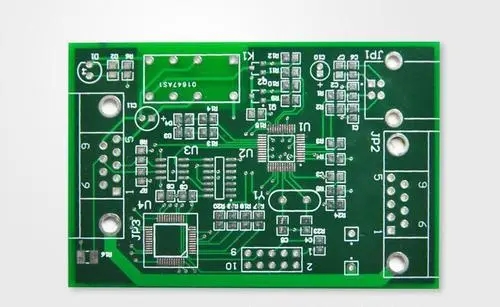Circuit and Pattern: printed circuit board is used as a tool for conducting between components. In the design, another large copper surface will be designed as grounding and power supply layer. The circuit and the drawing are made simultaneously.
Dielectric layer (Dielectric) : used to keep the insulation of the line and between layers, commonly known as the substrate.
Hole (Through hole/VIA) : Through hole can make the two levels of the line to conduct each other, the larger Through hole is used as a part plug-in, in addition to the non-through hole (nPTH) is usually used as a surface mount positioning, when the assembly of fixed screws.

Solder resistant /Solder Mask: Not all the copper surface should eat the tin parts, so the non-tin area will be printed with a layer of material (usually epoxy resin) to insulate the copper surface from Solder to avoid short circuit between non-tin wires. According to different technology, divided into green oil, red oil, blue oil.
Legend /Marking/Silk screen: this is an unnecessary component. The main function is to mark the name and position of each part on the circuit board, which is convenient for maintenance and identification after assembly.
Surface Finish: Due to the copper Surface in the general environment, it is easy to oxidize, leading to tin (poor solder), so it will be protected on the copper Surface to eat tin. Methods of protection have TIn spraying (HASL), gold (ENIG), Silver (Immersion Silver), TIn (Immersion TIn), organic flux (OSP), methods have advantages and disadvantages, collectively known as surface treatment.
PCB board and integrated circuit characteristics and differences introduced
Characteristics of PCB
Can be high-density. For decades, PCB density has evolved as integrated circuits have improved and installation technology has improved.
High reliability. Through a series of inspections, tests and aging tests, the PCB can be guaranteed to work reliably for a long period of time (generally 20 years).
Designability. For PCB performance (electrical, physical, chemical, mechanical, etc.) requirements, can be standardized design, standardization and so on to achieve printed board design, short time, high efficiency.
Productive. Adopt modern management, can carry on standardization, scale (quantity), automation and so on production, guarantee product quality consistency.
Testability. A relatively complete testing method, testing standards, various testing equipment and instruments have been established to test and appraise PCB products' qualification and service life.
Assemblability. PCB products not only facilitate standardized assembly of various components, but also can be automated, large-scale mass production. At the same time, PCB and various component assembly parts can also be assembled into larger parts, systems, until the whole machine.
Maintainability. Since PCB products and various component assemblies are standardized in design and mass production, these components are also standardized. Therefore, once the system fails, it can be replaced quickly, conveniently and flexibly to recover the system work quickly. Of course, much more could be said. Such as the system miniaturization, lightweight, signal transmission speed, etc.
Integrated circuit characteristics
The integrated circuit has the advantages of small volume, light weight, less lead wire and welding points, long life, high reliability, good performance, and low cost, convenient for mass production. It is not only widely used in industrial and civil electronic equipment such as radio recorder, TV set and computer, but also widely used in military, communication and remote control. Using integrated circuit to assemble electronic equipment, its assembly density can be increased dozens of times to thousands of times than the transistor, the stable working time of equipment can also be greatly improved.
The difference between PCB and integrated circuit
Integrated circuit is the integration that is to point to chip commonly, resemble the north bridge chip on motherboard, CPU interior, it is to call integrated circuit, original name also is to call integrated piece. And the printed circuit refers to the circuit board that we usually see, and so on, and the printed welding chip on the circuit board.
Integrated circuits (ICS) are welded to the PCB board; PCB version is the carrier of integrated circuit (IC). A PCB is a Printed circuit board (PCB). Printed circuit boards appear in almost every kind of electronic device. If there are electronic parts in a piece of equipment, printed circuit boards are mounted on PCBS of various sizes. In addition to fixing various small parts, the main function of the printed circuit board is to carry out the electrical connection between the parts.
To put it simply, integrated circuit is to integrate a universal circuit into a chip, which is a whole. Once it is damaged inside, the chip will be damaged, while PCB can weld components by itself, and components can be replaced if broken.